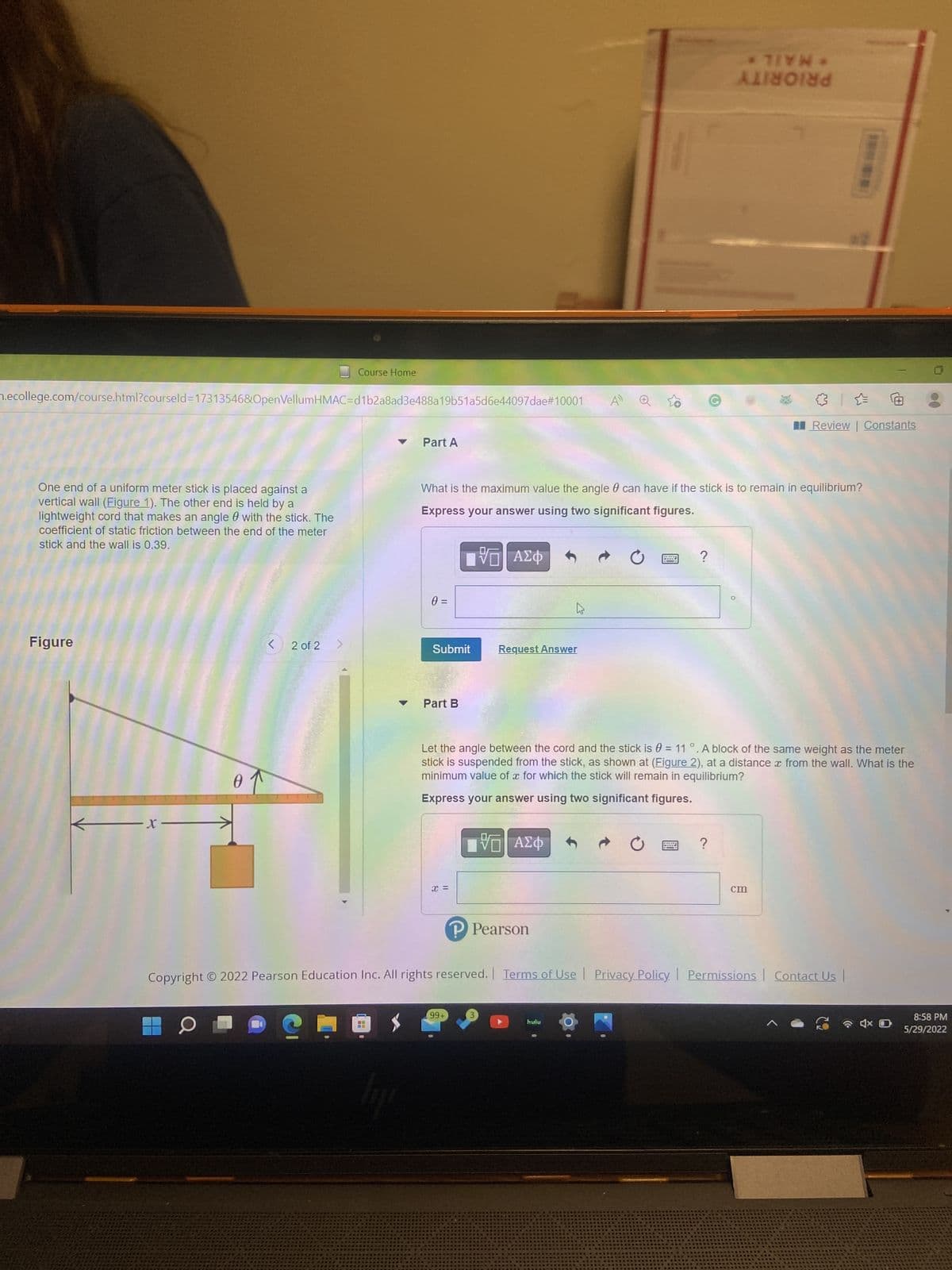One end of a uniform meter stick is placed against a vertical wall (Figure 1). The other end is held by a lightweight cord that makes an angle with the stick. The coefficient of static friction between the end of the meter stick and the wall is 0.39. Figure < 2 of 2 01 What is the maximum value the angle can have if the stick is to remain in equilibrium? Express your answer using two significant figures. ΙΠ ΑΣΦ ? h Request Answer Part B Let the angle between the cord and the stick is = 11 °. A block of the same weight as the meter stick is suspended from the stick, as shown at (Figure 2), at a distance from the wall. What is the minimum value of x for which the stick will remain in equilibrium? Express your answer using two significant figures. IVE ΑΣΦ ? 0 = Submit x = P Pearson cm
One end of a uniform meter stick is placed against a vertical wall (Figure 1). The other end is held by a lightweight cord that makes an angle with the stick. The coefficient of static friction between the end of the meter stick and the wall is 0.39. Figure < 2 of 2 01 What is the maximum value the angle can have if the stick is to remain in equilibrium? Express your answer using two significant figures. ΙΠ ΑΣΦ ? h Request Answer Part B Let the angle between the cord and the stick is = 11 °. A block of the same weight as the meter stick is suspended from the stick, as shown at (Figure 2), at a distance from the wall. What is the minimum value of x for which the stick will remain in equilibrium? Express your answer using two significant figures. IVE ΑΣΦ ? 0 = Submit x = P Pearson cm
An Introduction to Physical Science
14th Edition
ISBN:9781305079137
Author:James Shipman, Jerry D. Wilson, Charles A. Higgins, Omar Torres
Publisher:James Shipman, Jerry D. Wilson, Charles A. Higgins, Omar Torres
Chapter1: Measurement
Section1.3: The Senses
Problem 2PQ: How may our senses be enhanced?
Related questions
Concept explainers
Rotational Equilibrium And Rotational Dynamics
In physics, the state of balance between the forces and the dynamics of motion is called the equilibrium state. The balance between various forces acting on a system in a rotational motion is called rotational equilibrium or rotational dynamics.
Equilibrium of Forces
The tension created on one body during push or pull is known as force.
Question
100%
Part C. When angle = 11°, how large must the coefficient of static friction be so that the black can be attached 12 cm from the left end of the stick without causing it to slip

Transcribed Image Text:0 =
Submit
Course Home
m.ecollege.com/course.html?courseld=17313546&OpenVellumHMAC=d1b2a8ad3e488a19b51a5d6e44097dae#10001
AD
Part A
One end of a uniform meter stick is placed against a
vertical wall (Figure 1). The other end is held by a
lightweight cord that makes an angle with the stick. The
coefficient of static friction between the end of the meter
stick and the wall is 0.39.
What is the maximum value the angle 0 can have if the stick is to remain in equilibrium?
Express your answer using two significant figures.
IVE ΑΣΦ
?
h
Figure
< 2 of 2
Request Answer
Part B
Let the angle between the cord and the stick is = 11°. A block of the same weight as the meter
stick is suspended from the stick, as shown at (Figure 2), at a distance from the wall. What is the
minimum value of x for which the stick will remain in equilibrium?
of
Express your answer using two significant figures.
-x-
IVE ΑΣΦ
?
W
cm
P Pearson
Copyright © 2022 Pearson Education Inc. All rights reserved. Terms of Use | Privacy Policy. Permissions Contact Us |
99+
O
hulu
4x D
lije
* TIYN *
ANNE
x =
Ⓒ
Review | Constants
8:58 PM
5/29/2022
Expert Solution
This question has been solved!
Explore an expertly crafted, step-by-step solution for a thorough understanding of key concepts.
This is a popular solution!
Trending now
This is a popular solution!
Step by step
Solved in 2 steps with 4 images

Knowledge Booster
Learn more about
Need a deep-dive on the concept behind this application? Look no further. Learn more about this topic, physics and related others by exploring similar questions and additional content below.Recommended textbooks for you

An Introduction to Physical Science
Physics
ISBN:
9781305079137
Author:
James Shipman, Jerry D. Wilson, Charles A. Higgins, Omar Torres
Publisher:
Cengage Learning

An Introduction to Physical Science
Physics
ISBN:
9781305079137
Author:
James Shipman, Jerry D. Wilson, Charles A. Higgins, Omar Torres
Publisher:
Cengage Learning